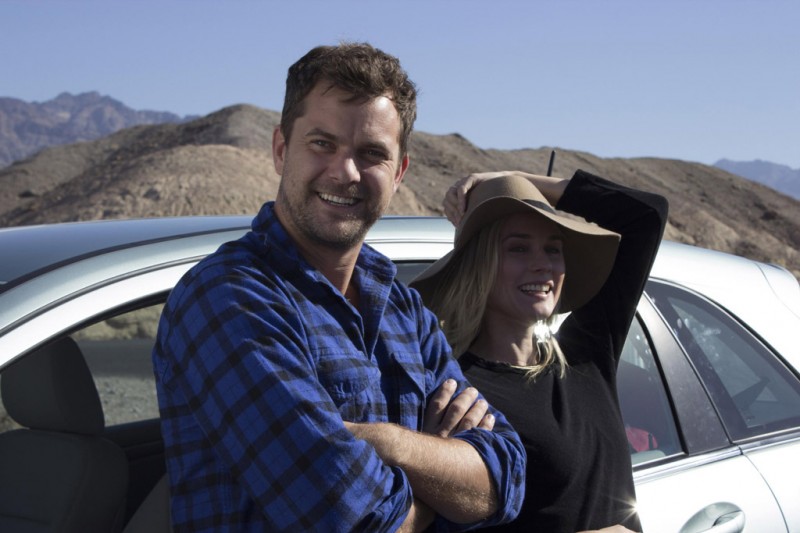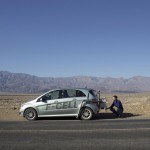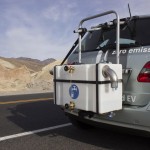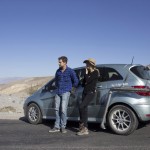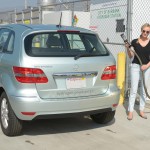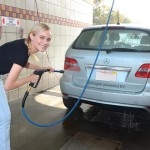As any fans of the actor Joshua Jackson will know, fringe science is nothing new to him. The star of hit TV series ‘Fringe’ has been driving around in a not so science fiction Mercedes-Benz B-Class F-CELL, a fuel cell powered B-Class. Likewise, actress Diane Kruger has been doing the same for over two years. Both stars are not the only ones though as the entire fleet of 70 F-CELL’s have travelled more than 1.6 million kilometres – an overall massive saving of fossil fuel and nearly 270 tonnes of carbon dioxide too, instead using pure Hydrogen to fuel electricity for the electric motors that give drive.
A total of around 200 vehicles have been with customers in the USA and Europe since 2010 and one of these vehicles already has 315,000 kilometres on the clock. Diane Kruger and Joshua Jackson are now showing just how much potential the fuel cell drive system offers – on a trip in California’s DeathValley, one of the driest places in the world.
“We’ve become absolute fans of the fuel cell. The car is so easy to use. On a day-to-day basis our normal mobility isn’t restricted at all – and we had no water problems in Death Valley either”, reported Diane Kruger.
“It takes three minutes to fill up, drives about 400 kilometres and gives off zero emissions – simply perfect”, added Joshua Jackson.
In the film “Defying Death Valley” the two of them are driving through the 50 degree Celsius heat of Death Valley – without any drinking water stock. Their lives rely on the emissions of the
B-Class F-CELL. The Hollywood stars are using the water, resulting out of the operation of the F-CELL, for drinking and cooking.
The B-Class F-CELL is the first fuel cell electric vehicle from Mercedes-Benz to be built under series-production conditions. The electricity required for driving is generated on board the car in a chemical reaction between hydrogen and oxygen. With a range of some 400 kilometres and short refuelling times of less than three minutes, the B-Class F-CELL combines emission-free mobility with absolute feasibility for use on long journeys and impressive performance.
Fuel cell technology is an integral component of Daimler’s long-term drive system strategy, with emission-free mobility as the culmination of these efforts. Professor Dr Thomas Weber, Member of the Board of Management of Daimler AG responsible for Group Research and Mercedes‑Benz Cars Development, commented:
“Our various projects in Germany, the USA and Norway and, not least, the Mercedes-Benz F-CELL World Drive, have shown that the time is right for fuel cell-powered electric vehicles and demonstrated the tremendous potential that exists for hydrogen as a source of energy. We are therefore all the more delighted that such well-known film stars have adopted a pioneering role in relation to this technology and call attention on the advantages of electric mobility.”
During the Mercedes-Benz F-CELL World Drive of 2011, three B-Class F-CELL vehicles took 125 days to drive 30,000 kilometres through 14 countries on four continents, in a convincing demonstration of the everyday viability of this technology. Joshua Jackson was one of those who took part in the first circumnavigation of the globe with fuel cell cars, driving a section of the route in the USA.
As well as almost 200 B-Class F-CELL, Daimler AG has brought 60 A-Class F‑CELL, three Sprinter vans and almost 60 buses with fleet tests into the market since 2001. Until now the more than 300 fuel cell vehicles have driven around nine million kilometres altogether, providing proof indeed of the unrestricted everyday viability and durability of fuel cell technology. In early 2013, in a bid to speed up the widespread market availability of this emission-free technology and to reduce investment costs, Daimler, Ford and Nissan reached a cooperation agreement covering the joint development of a fuel cell system.
The aim is to introduce a competitive fuel cell powered electric vehicle to market in 2017. It is envisaged that significant further progress will have been made by then, in particular towards creating a sustainable infrastructure – not least as a result of Daimler’s high level of involvement in various demonstration projects and within the framework of the H2 Mobility Initiative. This initiative has recently agreed to expand the current network of 15 filling stations in Germany’s public hydrogen infrastructure to about 400 H2 filling stations by the year 2023. This means that an H2 supply suitable for everyday use shall be created not only for densely populated areas and main traffic areas, but also for rural areas.
Source; Mercedes-Benz
